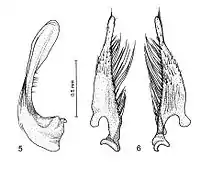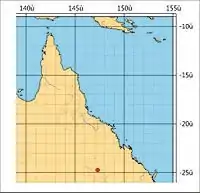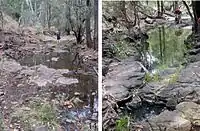Taxonavigation
| Taxonavigation: Adephaga |
|---|
|
Superregnum: Eukaryota |
Familia: Dytiscidae
Subfamilia: Agabinae
Genus: Platynectes
Species: Platynectes ponderi
Name
Platynectes ponderi Hendrich & Šťastný, 2014
Type locality
Between Lorikeet and Barking Owl Springs, 24.600S 147.868E, 436 m, Carnarvon National Park, Queensland, Australia.
Type material
Holotype: 1 male: “Australia Queensland, Carnarvon Station, unnamed spring btw Lorikeet & Barking Owl Springs, 24°48'S 147°52'5E, 18 Apr 2007 lgt. W.F.Ponder, A.Wells & W.Zeidler”, “Holotype Platynectes ponderi sp. n. Hendrich & Šťastný des. 2014” [red printed label] (AMS). Paratype, one female with same data as holotype but provided with red printed paratype label (AMS).
Diagnosis
Medium-sized Platynectes, oval, rather flat, shiny, black with seven deep striae and five yellow not interrupted longitudinal stripes on elytra. Pronotum with two stripes of deep longitudinal striae (Fig. 1).
Description
Measurements: Holotype: TL = 8.0 mm, TL-H = 7.4 mm; MW = 4.6 mm. Paratype: TL = 8.3 mm, TL-H = 7.5 mm; MW = 4.75 mm.
Head: black, dull, with one central large yellow marking reaching anterior margin, and two small spots not reaching posterior margin. Microreticulation absent. Reticulation strong, consisting of small meshes and of minute punctures inside meshes. A posterior row of deeper scratches between eyes, and two larger and deeper clypeal grooves on disc and transverse depression beside eyes. Antennae reddish, long; antennomeres slender. Apical two antennomeres reaching elytron.
Pronotum: shiny, testaceous; anterior and posterior margins each with black broad band that fuse medially. Covered with stripes of deep and well-marked longitudinal striae. Posterior angles of pronotum acute. Reticulation strong, consisting of strong and closed meshes without any punctures. Lateral margin, except in anterior fifth, almost completely bordered.
Elytron: black, shiny with five yellow not interrupted longitudinal stripes and two smaller yellow spots apically (not visible in Fig. 1), three spots on shoulder, and marginally a narrow yellowish one of variable length along posterior third of elytron (not visible in Fig. 1). Elytron with seven deep longitudinal striae of different length. Six striae covering from half to 3/4th of elytron, 1st stria interrupted and reaching only midlength of elytron. Two sutural stripes of 12 to 14 deep strioles roughly arranged into two columns. Epipleura rufo-testaceous. Reticulation fine but visible at usual magnification (80×), consisting of closed meshes and of minute punctures inside meshes.
Ventral surface: black. Legs rufo-testaceous. Prosternal process broad, 2 times as long as broad, distinctly bordered at sides, and pointed out at apex. Metaventral wings very narrow. Metacoxal lines raised, well separated, a little divergent in anterior half. Metacoxal plate with few shallow scratches, microreticulation consisting of minute punctures. Abdominal ventrites 2, 4 and 6 laterally with a testaceous spot. Last ventrite narrowly microreticulate with minute punctures and with very few oblique striations. Posterior margin bordered and broadly rounded.
Male: Protarsus little expanded, moderately clothed with setae ventrally. Aedeagus: Median lobe regularly curved, broadened at apical half and rounded at apex (Fig. 2 - 5). Parameres basally broader with long setae, apical quarter narrow and elongate (Fig. 2 - 6).
Sexual dimorphism: The female paratype is similar to the male holotype, but slightly larger and with pro- and mesotarsomeres 1–3 not dilated and without adhesive setae.
Affinities
Platynectes ponderi sp. n. is similar to P. weiri sp. n. but can be easily separated by the presence of seven striae on elytra instead of 10 striae in P. weiri sp. n., and the shape of the median lobe in aedeagus. Furthermore, the yellow not interrupted longitudinal stripes on elytron distinguishes the species from P. weiri sp. n.
Habitat
Lotic. Both specimens were collected in seepages in a creek bed, Carnarvon Range (Fig. 4 - 14 and 15). The species co-occurs with the widespread Platynectes octodecimmaculatus (W.S. Macleay, 1825).
Etymology
This species is dedicated to the Australian malacologist Dr Winston Ponder (Sydney, Australia) who collected the type specimens. The specific epithet is a substantive in the genitive case.
Distribution
(Fig. 3). Carnarvon Range. Only known from the type locality in south-eastern Queensland. A rare and highly endemic species.
Images
 Figure 1. Platynectes ponderi. (Photo: Michael Balke)
Figure 1. Platynectes ponderi. (Photo: Michael Balke) Figure 2. Median lobe and parameres of Platynectes ponderi. (Drawing: Jaroslav Šťastný)
Figure 2. Median lobe and parameres of Platynectes ponderi. (Drawing: Jaroslav Šťastný) Figure 3. Distribution map of Platynectes ponteri, south-eastern Queensland, Australia
Figure 3. Distribution map of Platynectes ponteri, south-eastern Queensland, Australia Figure 4. 14–15. Type locality of Platynectes ponderi sp. n.: Half-shaded seepages and rest pools in a creek bed, Carnarvon Range (Photos by Julie Ponder).
Figure 4. 14–15. Type locality of Platynectes ponderi sp. n.: Half-shaded seepages and rest pools in a creek bed, Carnarvon Range (Photos by Julie Ponder).
References
- Hendrich, L.; Šťastný, J. 2014: Taxonomic revision of Australian Platynectes Régimbart, 1879 (part I)—four new species from Queensland (Coleoptera: Dytiscidae, Agabinae). Zootaxa 3795(1): 25–37. DOI: 10.11646/zootaxa.3795.1.3 Reference page.